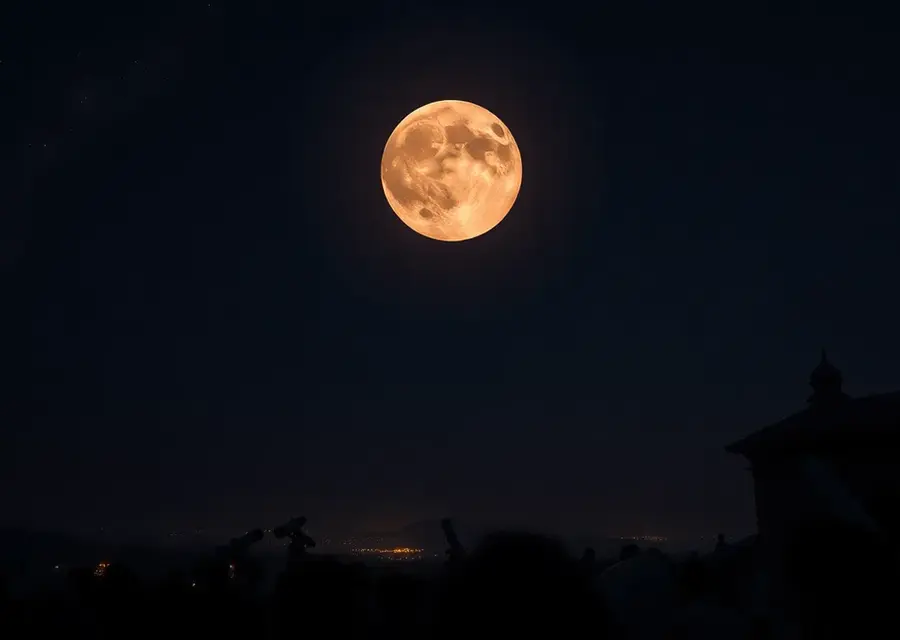Lunar Eclipse India Viewing: A Night of Blood Moon Public Observations
- THE MAG POST

- Sep 8
- 5 min read

Lunar eclipse India viewing invites communities to witness a celestial display that blends science with wonder across towns and temples. From urban plazas to rural skies, people stepped outside with curiosity and devices ready to capture the coppery Moon as it slid through the Earth's shadow, turning night into a shared spectacle.
This lunar eclipse India viewing moment underscored how science outreach can unite diverse audiences. Astronomers explained the mechanics while communities marked the event with prayers and rituals, and live streams brought distant watchers into living rooms and schools. The pairing of explanation and experience strengthens public understanding and collective curiosity.
Why the Blood Moon Captivates Public Imagination
Few celestial events invite both science and culture to the same stage, turning observers into participants.
Public Observatories Across Indian Cities
Bengaluru hosted gatherings at the Jawaharlal Nehru Planetarium, where telescopes framed the Moon’s darkening as the shadow slid across its disk. Kalaburagi’s Science Centre opened to visitors, turning a cloudy night into a shared learning moment with guided observations and child-friendly explanations. In Bengaluru, the Association of Bangalore Amateur Astronauts traces its roots to 1976 and keeps public watching alive.
Across other centers, amateurs and educators used outreach programs to bring astronomy into homes and schools. In Nashik’s Ramkund, saints and devotees joined special mantras and meditations as a complement to scientific narration, illustrating how reverence and inquiry can share the same night. Observers on streets, terraces, and temple precincts translated the eclipse into a moment for education, curiosity, and communal reflection.
Cultural Practices and Rituals During the Eclipse
Devotees gathered at Dashashwamedh Ghat to observe the onset of totality, performing holy baths and meditation as part of the night’s atmosphere. At Ramkund in Nashik, communities synchronized chants with the scientific explanations flowing from guides and researchers nearby. The event became a mosaic where ritual devotion and empirical curiosity walked hand in hand.
Temples and cultural groups marked the celestial event with prayers, reflections, and storytelling, while observers shared tips on how to view the Moon safely through telescopes and binoculars. The convergence of watching, learning, and prayer transformed a rare phenomenon into a communal rite of learning and wonder.
What Causes the Lunar Eclipse's Red Hue?
The coppery disk is a product of Earth’s atmosphere shaping the light that reaches the Moon during an eclipse.
The Science Behind the Coppery Disk
During a total lunar eclipse the Moon passes through Earth’s shadow, yet some sunlight still reaches it. As this light traverses our atmosphere, shorter blue wavelengths scatter more readily than red ones, bathing the Moon in a reddish tint that observers often describe as blood red. This explanation aligns with the statements from astrophysicists who study light propagation and scattering in planetary atmospheres.
Noting duration and visibility, the long view of such eclipses helps observers connect theory with experience. The current event, lasting about 82 minutes of totality, was the longest total lunar eclipse visible from India since 2022, offering a clear window for both amateur observers and professional researchers to compare notes and images.
Observational Highlights and Skywatching Etiquette
Observers used a mix of street viewing, telescope sessions, and public lectures to experience the coppery Moon. Booklets and guides accompanied the crowds, clarifying how to align instruments, time the phases, and capture photographs without introducing glare or misalignment. The night became a coordinated celebration of curiosity and technique.
As clouds occasionally veiled the Moon, communities leaned on online streams to sustain the shared encounter. This combination of on-site observation and digital augmentation underscored how modern astronomy blends fieldwork with remote access, ensuring no one misses the spectacle due to weather or distance.
Streaming the Sky: Live Observations Expand Access
Public fascination rose when screens bridged the gap between local vantage points and global expertise.
The Role of Live Streams
A rising tide of astronomy enthusiasts worldwide set up live streams, letting millions witness the eclipse even when cloud cover obscured the Moon locally. These streams offered real-time commentary, close-up footage from telescopes, and expert explanations that complemented what observers saw with their own eyes. The digital thread connected classrooms, homes, and planetariums across borders.
Streaming also democratized learning, inviting first-time skywatchers to engage with data, photography tips, and safe viewing practices. The shared online experience created a sense of global participation around a distinctly Indian celestial event, reinforcing that science communication can leverage technology to widen access and deepen understanding.
Weather and Visibility Challenges
Cloudy conditions in several parts of the country tempered the on-ground spectacle, but live streams helped preserve the experience for remote audiences. Observers with clear skies enjoyed crisp views, while others relied on recorded footage, time-lapse sequences, and scientist-led explainers to reconstruct the event’s progression. The mix of conditions highlighted both the limits and resilience of public astronomy.
Despite atmospheric hurdles, the eclipse became a teaching moment about observational redundancy and the value of multiple viewing modalities. The collaboration between field observers and online hosts illustrated how science communication can adapt to environmental variability while maintaining engagement and educational impact.
Preparing for Future Eclipses: Tips for Observers
As communities anticipate the next big alignment, practical guidance can help maximize learning and safety.
Plan Safe Viewing Experiences
Organizers emphasize person-centered safety, recommending eye protection when observing near sunrise or sunset phases and encouraging the use of proper telescopes, tripods, and solar filters during any near-sun viewing. For families and schools, structured programs with guided introductions and scheduled demonstrations improve comprehension while minimizing risk.
In practice, observers should check local weather forecasts, confirm telescope accessibility, and arrange accessible viewing points that accommodate diverse ages and mobility needs. This preparation turns a memorable night into a repeatable, educational experience that strengthens community science literacy.
Engaging Community Through Education
Educational outreach linked astronomy clubs, planetariums, and cultural organizations to broaden participation. In cities like Bengaluru, partnerships between amateur associations and science centers created ongoing opportunities for hands-on learning, citizen science projects, and public lectures. This model demonstrates how informal networks can sustain scientific curiosity beyond a single event.
Next eclipses offer a chance to refine outreach, share data-driven insights, and foster inclusive observation spaces. By weaving together storytelling, demonstrations, and citizen science, communities can transform celestial events into durable educational legacies that inspire future generations.
Key Takeaways
The blood moon showcased how astronomy and culture can coalesce, turning a rare eclipse into a nationwide learning moment. Public observatories, rituals, and live streams collectively broaden access to science, while the coppery glow provides a tangible demonstration of atmospheric optics and celestial mechanics. What we witnessed was more than a sight; it was a catalyst for curiosity that travels beyond the night sky.
Aspect | Highlights |
Event | Lunar eclipse visible in India with public viewing |
Key Venues | Jawaharlal Nehru Planetarium (Bangalore), Kalaburagi Science Centre, Ramkund (Nashik), Dashashwamedh Ghat |
Cause of Color | Sunlight refracted through Earth's atmosphere scatters blue, red hue dominates |
Duration | Approximately 82 minutes of totality |
From our network :
SQL Server Stored Procedure for Risk Reporting: Analyzing Risk Data by Month and Module
How to Find the Disk Space Used by Each Table in Your SQL Server Database
Linux Cache Eviction: How to Clear System Cache Without Root Privileges
Comprehending the Additive Inverse of an element: An Essential Mathematical Principle
World’s Largest Biohybrid Robot Hand: A Breakthrough in Robotics




















































Comments